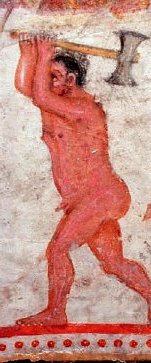Thracian religion includes the religious practices of the Thracians. Little is known about their mythology and rituals, but some of their gods are depicted in statuary or described in Greek sources.
Cults
One notable cult, attested from Thrace to Moesia and Scythia Minor, is that of the “Thracian horseman”, also known as the “Thracian Heros”, at Odessos (Varna) attested by a Thracian name as Heros Karabazmos, a god of the underworld usually depicted on funeral statues as a horseman slaying a beast with a spear.
Deities

Detail of the main fresco of the Aleksandrovo kurgan. The figure is identified with Zalmoxis.
Greek historian Herodotus wrote that the Thracians worshipped a triad of gods whom the Greeks equated with Dionysus, Ares and Artemis.
Known Thracian deities include:
- Sabazios, the Thracian reflex of Indo-European Dyeus, identified with Heros Karabazmos, the “Thracian horseman”. He gained a widespread importance especially after the Roman conquest. After Christianity was adopted, the symbolism of Heros continued as representations of Saint George slaying the dragon (compare Uastyrdzhi/Tetri Giorgi in the Caucasus).
- Zibelthiurdos (also “Zbelsurdos”, “Zibelthurdos”): a god recognized as similar to the Greek Zeus as a wielder of lightning and thunderbolts.
- Kotys (“Cotys”, “Cotto”, “Cottyto”, “Cottytus”), a goddess worshipped with much revelry by Thracian tribes such as the Edonians in the festival Cotyttia. A cult of Cottyto existed in classical Athens. According to Greek sources her priests were called baptes or “washers” because their pre-worship purification rites involved bathing. Her worship included midnight orgies (orgia). Her name is believed to have meant “war, slaughter”, akin to Old Norse Höðr “war, slaughter”.
- Pleistoros, to which prisoners of war were sacrified.
Several Thracian deities show close analogy to the Greek cult of Dionysus, Orpheus and Persephone (the Dionysian Mysteries):
- Bendis was a Thracian goddess of the moon and the hunt whom the Greeks identified with Artemis, and hence with the other two aspects of formerly Minoan goddesses, Hecate and Persephone.
- Zemelā is probably a cognate of the Proto-Indo-European Earth goddess Dhéǵhōm, akin to Lithuanian Žemyna and Latvian Zemes Māte, both of which are “Mother Earth” goddesses.
Known Dacian theonyms include:
- Zalmoxis, identified by some with the thunder-god Gebeleïzis, an important god of the Dacians and Thracians.
- Derzelas (also “Darzalas”) was a chthonic god of health and human spirit’s vitality.
Philologist Aleksandar Loma cited that Asclepius, god of healing and medicine, was worshipped by the Thracians under the title “Ζυλμυ-δρηνός” or some variation thereof.
Kogaionon was the name of a holy mountain of the Dacians.
